A newly developed biosensor that harnesses the power of nanophotonics is able to detect the secretion of cytokines — small inflammatory molecules that play important roles in cancer — from single lymphoma cells, a study reports.
The new lab-on-chip technology offers researchers insight into how cells behave and communicate, which could lead to the development of more targeted cancer treatments in the future. It was developed through a joint collaboration between RMIT University in Australia, École polytechnique fédérale de Lausanne, and Ludwig Institute for Cancer Research in Lausanne, Switzerland.
The study, “Label-Free Optofluidic Nanobiosensor Enables Real-Time Analysis of Single-Cell Cytokine Secretion,” was published in the journal Small.
Researchers have been studying the behavior of groups of cells for a long time. However, over the past decade, they have become increasingly interested in finding out how individual cells behave.
“We know a lot about how groups of cells communicate to fight disease or respond to infections but we still have a lot to learn about individual cells,” Arnan Mitchell, PhD, director of RMIT’s MicroNano Research Facility, said in a press release. “Studies have recently shown that you can take two cells of the same type and give them the same treatment but they will respond very differently.”
Cell-to-cell communication is vital for any population of cells in the human body. To treat cancer, it is critical to understand how individual cancer cells interact and communicate. One of the major ways through which cells communicate is by releasing small proteins called cytokines.
While it is commonplace to detect levels of individual cytokines from a large population of cells, determining the secretion profile of individual cells is quite difficult because cytokines are very small and are secreted in miniscule amounts, making direct detection of single-cell secretion in real time very challenging.
Researchers overcame this issue by creating an integrated optofluidic biosensor that can isolate single cells from a large population, and subsequently monitor the chemicals they produce in real time over the course of at least 12 hours.
To do this, they used microfluidic chip technology, which “offers a powerful tool to create a highly miniaturized environment with compartmentalization for the analysis,” according to the study.
Essentially, the biosensor is made up of billions of tiny nanoholes in a chamber containing an isolated cell, as well as ligands and antibodies that are positioned to capture specific molecules secreted by the cell.
When a light source shines on the chamber, an optical phenomenon known as the plasmonic effect allows the transmission of a single color of light. When a cell secretes a molecule and it attaches to the antibodies, it changes the frequency of light transmitted, which is how specific molecules can be identified. This allows for continuous monitoring of the cytokines produced from each individual cell.
“With these capabilities, the proposed nanoplasmonic biosensor system represents a powerful tool to analyze cytokine secretion at the single-cell level in a label-free and real-time manner,” the investigators concluded in the study.
Using this new method, researchers found that each lymphoma cell produces varying amounts of the cytokine interleukin-2 at different times, indicating that each cell has a unique footprint.
By building on this data, researchers hope to one day identify which subsets of cancer cells are “good” and which ones are “bad,” allowing them to design treatments that specifically target the aggressive cancer cells.
“It’s a powerful new tool that will give us a deeper fundamental understanding of cell communication and behaviour. These insights will open the way to develop radically new methods for diagnosing and treating disease,” Mitchell said.


